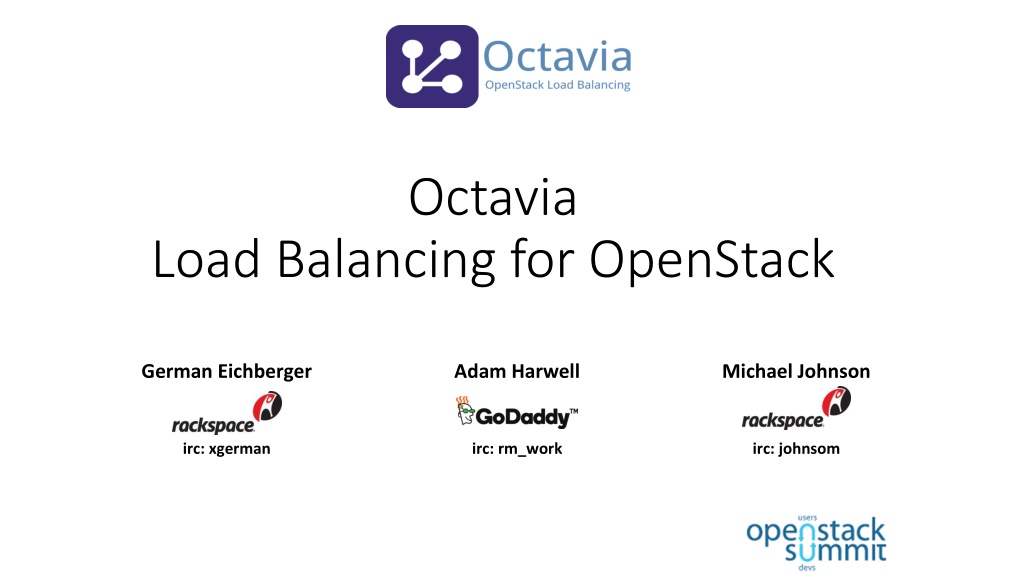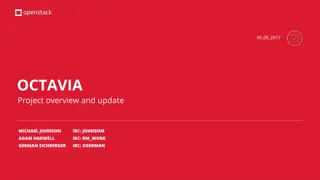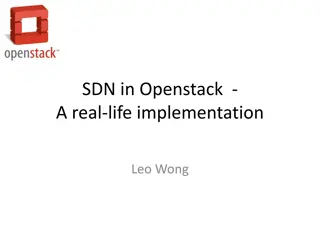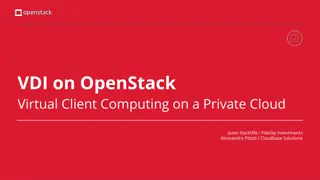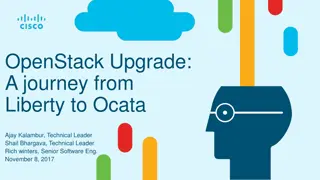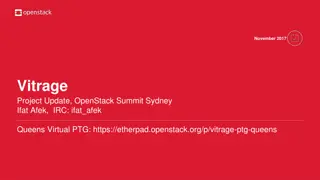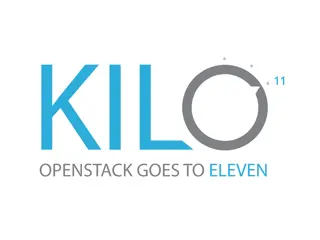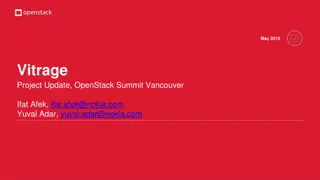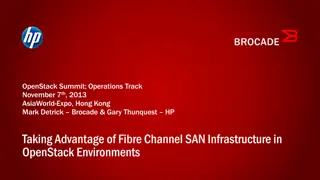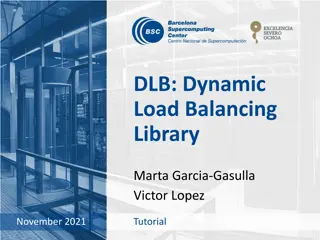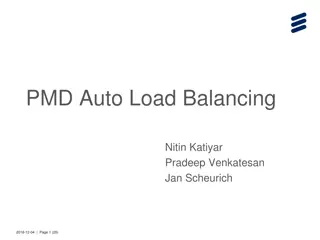Octavia Load Balancing for OpenStack Transition Overview
Introduction to Octavia as an official top-level project in OpenStack, detailing the transition from Neutron-LBaaS, the reasons behind the merge, benefits of the transition, roadmap, and the tools provided for a smooth migration process.
Download Presentation

Please find below an Image/Link to download the presentation.
The content on the website is provided AS IS for your information and personal use only. It may not be sold, licensed, or shared on other websites without obtaining consent from the author. Download presentation by click this link. If you encounter any issues during the download, it is possible that the publisher has removed the file from their server.
E N D
Presentation Transcript
Octavia Load Balancing for OpenStack German Eichberger Adam Harwell Michael Johnson irc: xgerman irc: rm_work irc: johnsom
Agenda Introduction OpenStack User Survey 2016 and 2017 Octavia is an official top level project Neutron-LBaaS merging into Octavia Why are we doing this? The Neutron-LBaaS Transition Octavia Overview What was new in Ocata What is new in Pike Roadmap Related Sessions
April 2016 OpenStack User Survey We are here
April 2017 OpenStack User Survey We are still here
Octavia is an official top level project Octavia is an official OpenStack project and no longer a sub-project of Neutron. OpenStack repositories under Octavia are: octavia octavia-tempest-plugin python-octaviaclient octavia-dashboard neutron-lbaas neutron-lbaas-dashboard
Neutron-LBaaS merging into Octavia As part of the Neutron stadium decomposition, LBaaS is no longer a Neutron sub-project! To simplify the codebase for LBaaS we are merging neutron-lbaas into Octavia. This means a superset of the LBaaS v2 API will be available through the Octavia API service. At the completion of this work, neutron-lbaas will be deprecated for removal. Neutron-lbaas CLI in neutron client is also deprecated following the overall neutron client s deprecation
Why are we doing this? Octavia and Neutron can be running different versions Deployment and packaging will be easier as you will no longer need to install a Neutron extension Improve API performance and simplify the experience for TLS offloading load balancers We will no longer need to modify code in up to three repositories to add features to the API We will no longer be maintaining state in two databases Prevent LBaaS drivers from bypassing stable APIs
The Neutron-LBaaS Transition We have provided a pass-through proxy driver for neutron-lbaas that forwards requests made via the neutron endpoint to the new Octavia endpoint We plan to provide migration documentation and tools that will allow you to migrate existing load balancers to Octavia neutron-lbaas and the new Octavia endpoint can run at the same time We plan to provide a shim driver to allow existing neutron-lbaas vendor drivers to run inside Octavia with minimal changes New OpenStack client will exclusively support Octavia endpoint
HAProxy Namespace Driver Is neither scalable nor highly available, and has little tenant isolation We understand there is still demand for this some installations (eg. Dev/Test) Will be moved out of tree Needs to be refactored to work with stable Neutron APIs Will not be our focus going forward If you use this, it could use your support!
What was new in Ocata Amphora image support for CentOS/Fedora/RHEL Added Amphora support for Ubuntu Xenial and systemd Support for PKCS7 encoded intermediate certificate bundles Octavia v2 API preparation: Keystone authentication for the Octavia API RBAC policy support for the Octavia API Quotas in the Octavia API
What is new in Pike Octavia v2 API endpoint with new API reference documentation OpenStack Ansible role to install Octavia TripleO support for deploying Octavia (WIP) Full support for Python 3.5 OpenStack client plugin (WIP) Single call create for fully configured load balancers Cascade delete PROXY protocol support
OpenStack OpenStack Ansible Ansible OpenStack Ansible is a project to deploy OpenStack on a (production) cloud New Octavia-ansible project which will deploy Octavia and configure it Fully integrated: If you install Octavia, Neutron + etc. will be reconfigured Flexible: Management network, certificates, images, etc. are all configurable Supports different topologies Incorporates best practices from our deployments Has been already deployed successfully Docs: https://docs.openstack.org/developer/openstack-ansible-os_octavia/
Octavia Roadmap Note: This roadmap WILL change based on project team gathering discussions. Octavia v0.10 Ocata Octavia v1.0 (WIP) Pike Octavia - Future Active/Active amphora Amphora horizontal scale Container support Flavor framework support Support CentOS/Fedora/RedHat amphora images Native quotas Framework for Octavia v2 API Octavia v2 API complete PROXY protocol support Full Python 3.5 support OpenStack Client plugin Single call actions Boston Update
Related Sessions Sessions Introduction to OpenStack Load Balancing Tue 9th 4:40pm-5:20pm - Hynes Convention Center - Level 3 - MR 312 Octavia Project Update Wed 10th 11:50am-12:30pm - Hynes Convention Center - Level 2 - MR 203 Hands-on lab Octavia Mon 8th, 2:00pm-3:30pm - Sheraton Boston Hotel - 2nd Floor - Back Bay Ballroom C/D
Q & A / Panel discussion Weekly meetings: Wednesday @ 20:00 UTC in #openstack-meeting-alt Freenode IRC: #openstack-lbaas https://wiki.openstack.org/wiki/octavia http://www.octavia.cloud https://launchpad.net/octavia https://github.com/openstack/octavia We are irc: johnsom, irc: rm_work, irc: xgerman
